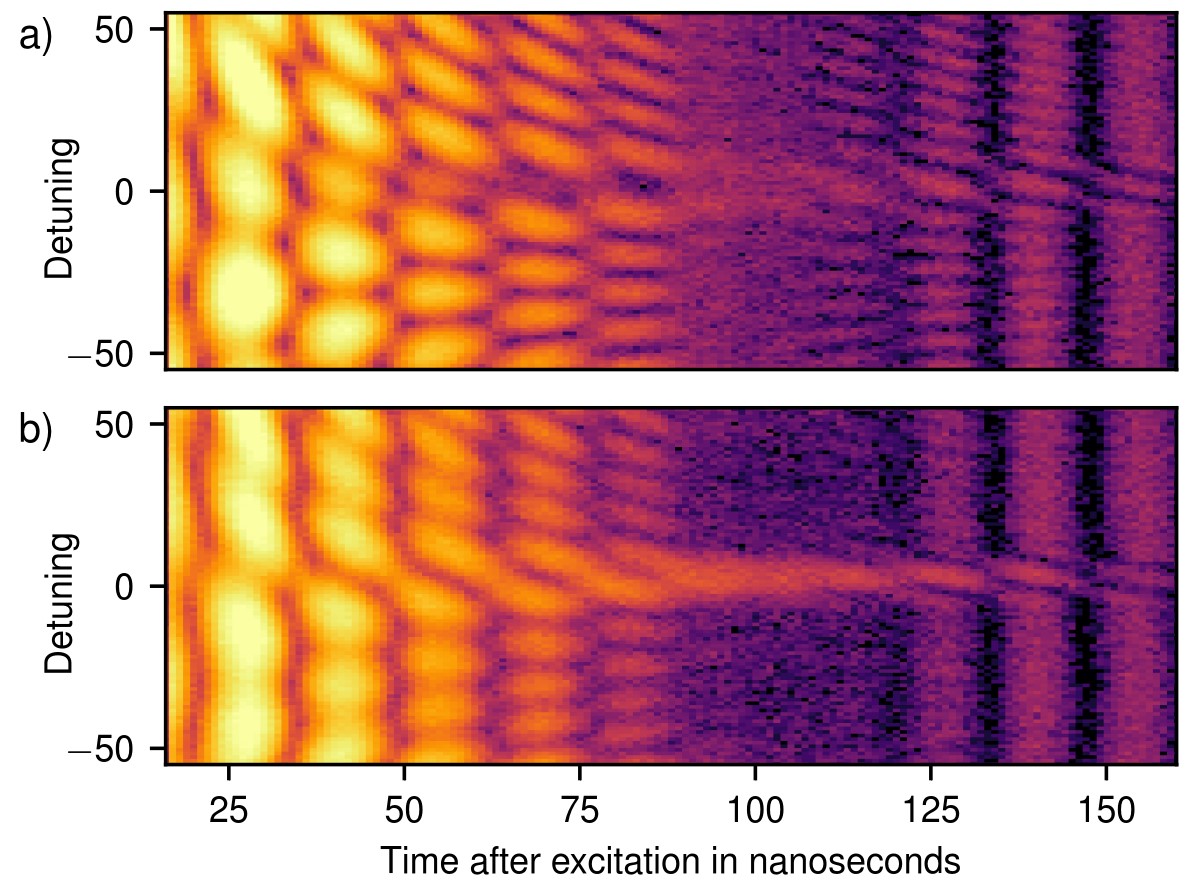- Home
- News
- Spotlight on Science
- X-ray double flashes...
X-ray double flashes control atomic nuclei
17-02-2021
A team of researchers have used the nuclear resonance beamline ID18 to coherently control nuclear excitations with X-ray light for the first time, achieving a temporal control stability of a few zeptoseconds (a trillionth of a billionth of a second). This forms the basis for new experimental approaches exploiting the control of nuclear dynamics, which could lead to more precise time standards.
In the field of atomic dynamics, far-reaching control is the key to many applications, for example, the control of chemical reactions or the development of new, more precise time standards. Modern experiments on quantum dynamics can control the quantum processes of electrons in atoms to a large extent by means of laser fields. However, the inner life of atomic nuclei usually plays no role because their characteristic energy, time and length scales are so extreme that they are practically unaffected by the laser fields. Fresh approaches breathe new life into nuclear physics by exploiting this insensitivity to external disturbances and using the extreme scales of the atomic nuclei for particularly precise measurements. Thus, atomic nuclei can respond to X-rays with an extremely well-defined energy by exciting individual nucleons – similar to electrons in the atomic shell. These transitions can be used as clockworks for precise nuclear clocks, and this requires the measurement of nuclear properties with the highest precision.
A team of researchers from the Max Planck Institute for Nuclear Physics in Heidelberg, in collaboration with researchers from DESY and Helmholtz Institute Jena, have measured the quantum dynamics of atomic nuclei, and also used suitably shaped X-ray pulses at the nuclear resonance beamline ID18 to control them, with a previously unattained temporal stability of a few zeptoseconds – a factor of 100 better than anything previously achieved. This opens the toolbox of coherent control, which has been successfully established in optical spectroscopy, to atomic nuclei – providing completely new possibilities and perspectives.
Coherent control uses the wave properties of matter to control quantum processes via electromagnetic fields, e.g., laser pulses. In addition to the frequency or wavelength, each wave phenomenon is characterised by the amplitude (wave height) and phase (temporal position of wave crests and troughs). A simple analogy is the control of an oscillating swing by periodic, wave-like pushing. For this, the exact timing (phase) of the push relative to the swing motion has to be controlled. If the oncoming swing is pushed, it is decelerated. If, on the other hand, it moves away, its deflection is increased by the push. Analogously, the quantum-mechanical properties of matter can be controlled via correspondingly precise steering of the applied laser fields.
In the past decades, there has been great progress and success in the coherent control of atoms and molecules, with a temporal precision of light down to the attosecond range (a billionth of a billionth of a second), which corresponds to the natural time scale of electrons in atoms. In recent years, the availability of novel radiation sources for X-rays with laser quality (synchrotron radiation and free-electron lasers) has opened up a new field: nuclear quantum optics.
The researchers brought two samples enriched with the iron isotope 57Fe to beamline ID18, and irradiated them with short X-ray pulses (Figure 1). In the first sample, a controllable double X-ray pulse was generated, and then used to control the dynamics of the nuclei in the second sample. The investigated nuclear excitations – which de-excite again by X-ray emission – are characterised by a very high sharpness in energy: so-called Mössbauer transitions.

Fig. 1: Schematic set-up of the experiment. The double pulse generated in the first sample induces quantum dynamics in the atomic nuclei of the second sample, which can be controlled by delaying a part of the double pulse.
The first pulse excites a quantum-mechanical dynamic in the nucleus, analogous to the oscillating swing. The second pulse changes this dynamic, depending on the relative phase of the two X-ray pulses. For example, if the wave of the second pulse hits the second sample in phase with the nuclear dynamics, the nuclei are further excited. By varying the relative phase, the researchers were able to switch between further excitation of the nuclei and de-excitation of the nuclei, and thus control the quantum-mechanical state of the nuclei. This can be reconstructed from the measured interference structures of the X-ray radiation behind the second sample (Figure 2).

Fig. 2: Observed X-ray interference structures as a function of time (t) and detuning (δ) of the two samples against each other.
a) Measurement data for the case of enhanced emission, (b) for the case of enhanced excitation.
The possibilities demonstrated here open the door to new experimental approaches based on the control of nuclear dynamics, e.g., by preparing nuclei in particular quantum states allowing for measurements that are more precise.
Principal publication and authors
Coherent X-ray-optical control of nuclear excitons, K.P. Heeg (a), A. Kaldun (a), C. Strohm (b), C. Ott (a), R. Subramanian (a), D. Lentrodt (a), J. Haber (b), H.-C. Wille (b), S. Goerttler (a), R. Rüffer (c), C.H. Keitel (a), R. Röhlsberger (b,d,e,f,g), T. Pfeifer (a), J. Evers (a), Nature (2021); https://doi.org/10.1038/s41586-021-03276-x.
(a) Max-Planck-Institut für Kernphysik, Heidelberg (Germany)
(b) Deutsches Elektronen-Synchrotron DESY, Hamburg (Germany)
(c) ESRF
(d) The Hamburg Centre for Ultrafast Imaging, Hamburg (Germany)
(e) Helmholtz-Institut Jena, Jena (Germany)
(f) GSI Helmholtzzentrum für Schwerionenforschung GmbH, Darmstadt (Germany)
(g) Institut für Optik und Quantenelektronik, Friedrich-Schiller-Universität Jena, Jena (Germany)



